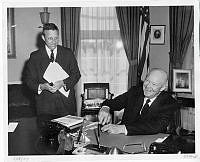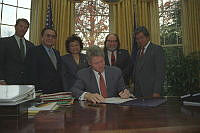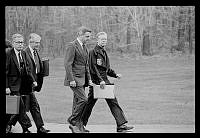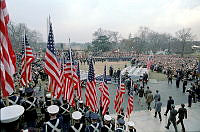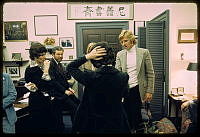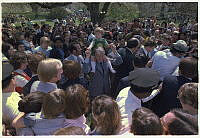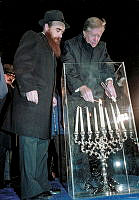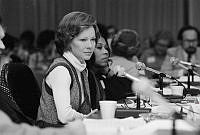Franklin D. Roosevelt

Assuming the presidency during the Great Depression, Franklin D. Roosevelt helped the American people regain faith in themselves. He brought hope as he promised prompt, vigorous action, and asserted in his first Inaugural Address that "the only thing we have to fear is fear itself."
Born on January 30, 1882 at Hyde Park, New York, he attended Harvard University and Columbia Law School. On St. Patrick's Day, 1905, he married his distant cousin Eleanor Roosevelt.
Following the example of his fifth cousin President Theodore Roosevelt, whom he greatly admired, Franklin Roosevelt entered public service through politics, but as a Democrat. He won election to the New York Senate in 1910. President Wilson appointed him assistant secretary of the navy in 1913, and he was the Democratic nominee for vice president in 1920.
In the summer of 1921, when he was 39, disaster hit — he was stricken with poliomyelitis. Demonstrating indomitable courage, he fought to regain the limited use of his legs, particularly through swimming. At the 1924 Democratic convention, he dramatically appeared on crutches to nominate Al Smith as "the Happy Warrior." In 1928 Roosevelt became governor of New York.
He was elected president in November 1932, to the first of four terms. By March there were 13 million people unemployed, and almost every bank was closed. In his first "hundred days," he proposed, and Congress enacted, a sweeping program to bring recovery to business and agriculture, relief to the unemployed and to those in danger of losing farms and homes, and reform, especially through the establishment of the Tennessee Valley Authority.
By 1935 the nation had achieved some measure of recovery, but businessmen and bankers were turning against Roosevelt's New Deal program. They feared his experiments, scorned his decisions to take the nation off the gold standard and allow deficits in the budget, and disliked the concessions to labor. Roosevelt responded with a new program of reform: Social Security, heavier taxes on the wealthy, new controls over banks and public utilities, and an enormous work relief program for the unemployed.
In 1936, although the nation was still mired in depression, he was reelected over Kansas Governor Alfred Landon by a huge margin. Bolstered by a popular mandate, he sought legislation to enlarge the Supreme Court, which had invalidated many New Deal programs. However, Roosevelt’s “court packing” proposal failed and never received a vote in Congress.
Roosevelt sought to keep the United States out of the growing crisis as Adolf Hitler marched through Europe, yet sought to strengthen nations threatened or attacked. After France fell and England came under siege in 1940, he began to send Great Britain all possible aid short of actual military involvement.
When the Japanese attacked Pearl Harbor on December 7, 1941, Roosevelt organized the nation's manpower and resources for a global war that, he hoped, would culminate in a victory for democracy. Mindful of the mistakes made after World War I, he devoted much thought to the planning of a United Nations. Roosevelt signed an executive order in 1942 which ordered the relocation and containment of Japanese Americans in military internment camps. The Supreme Court heard two challenges to the existence of the camps, but the executive order was upheld both times.
As the war drew to a close, Roosevelt was elected to a fourth term in November 1944; the only president to serve more than two terms. His health deteriorated as his final term started, and on April 12, 1945, while at his “Little White House” retreat in Warm Springs, Georgia, he died of a cerebral hemorrhage.














